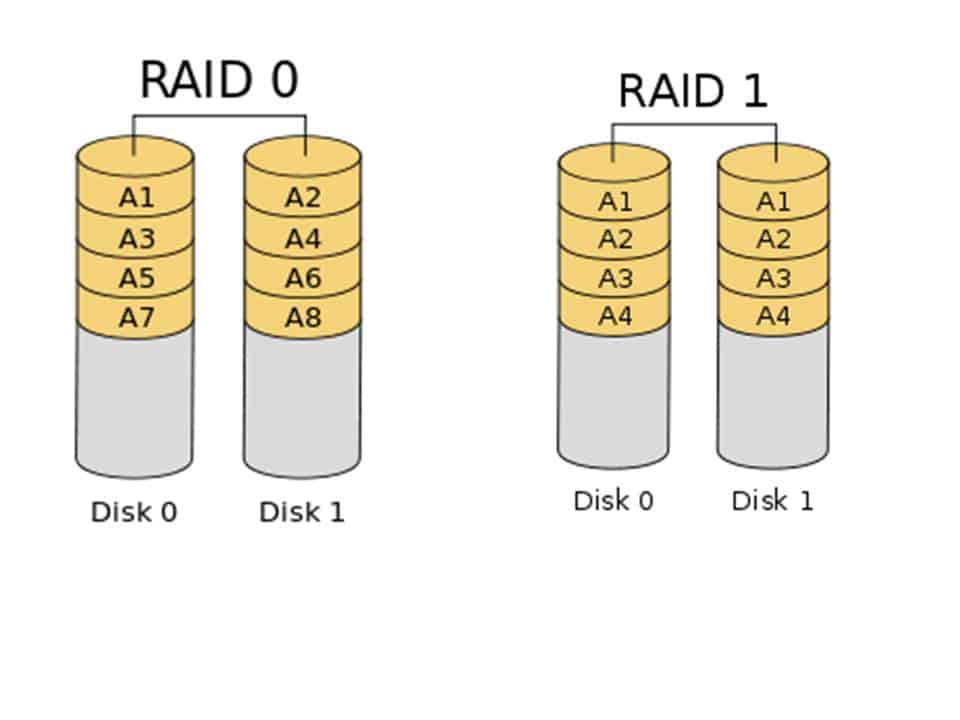What is RAID 5?
RAID 5 (“Redundant Array of Independent Disks 5” or “Redundant Array of Inexpensive Disks 5”) represents storage technology that combines multiple disk components into a logical unit for data redundancy and performance improvement. Using RAID 5 technology, we can write data to classic HDD or SSD devices using parity information or bonus data to calculate lost information. Striping additionally permits clients to recreate information in the event of a disk failure.
5 (“Redundant Array of Independent Disks 5” or “Redundant Array of Inexpensive Disks 5”) represents storage technology that combines multiple disk components into a logical unit for data redundancy and performance improvement. Using RAID 5 technology, we can write data to classic HDD or SSD devices using parity information or bonus data to calculate lost information. Striping additionally permits clients to recreate information in the event of a disk failure.
Now let us see older technology, RAID 0.
What is RAID 0?
Raid 0, stripe set, or striped volume represents storage technology that splits data across two or more disks without fault tolerance or redundancy. RAID 0 optimizes the speed of hard drives. If one disk fails, total data loss will result.
RAID 0 vs. RAID 1
RAID 0 splits data across two or more disks without fault tolerance or redundancy, while RAID 1 uses the mirroring concept and consists of an exact copy of a set of data on two or more disks. The main difference is that RAID 1 has better-read performance and reliability, while RAID 0 has better write performance and data storage capacity.

Like RAID 0, a JBOD exhibit utilizes all accessible stockpiling limits, not holding any for repetition. This makes a JBOD cluster a financially savvy option, in contrast to many RAID exhibits. However, JBOD exhibits don’t approach the speed of RAID with regards to peruses and compose, particularly not the accelerated peruses and composes of RAID 0.
SSDs are gaining popularity as costs go down due to their fast speeds. Of all the RAID levels, RAID 0 is the closest to SSDs’ peruse and compose speeds.
RAID 0 works by writing half of the data to one disk and half to the other. This method of writing is called stripping, and as a result, it has a very low tolerance for failures. Namely, 100% of the data is lost if one of the disks fails. However, the data will be written twice as fast because it is written in half on each disk. So, with two 500 MB / s SSDs, you can achieve up to 1 GB / s speeds. Of course, this way, you can connect three or more disks in a row, thus increasing the write speed as often as you have connected the disks.
You have also reduced the security of your data by as many times as there are disks in the RAID 0 array because if any disk fails, you have lost 100% of the data. To avoid confusion, the read and write speeds of multiple disks will depend on the speed of the RAID controller you use, most commonly built into the Southbridge chipset on your motherboard. But there are also RAID controllers that you can connect via e-PCI slots on the motherboard. Depending on the chipset, i.e., the e-PCI RAID controller, you may encounter various features or limitations when creating a RAID array.
While costs are dropping, an SSD remains essentially more costly than a prudent RAID cluster, so the choice between them, at last, comes down to focusing on speed and execution versus costs. So, what is BTRFS? If you have ever read the BTRFS man page, you might get an idea of what this tool does. BTRFS stands for Big File System, a file system designed to efficiently use immense block-like structures called file clusters. This post will use the FreeBSD ports tree to pull in the following package to create a thin BTRFS volume. RAID 0 (partition striping) “takes a partition to fill u.”. Ransomware: Defaults to encrypt files within existing partitions. Changes the encryption pattern from a known pattern of lines to a random pattern, then defragments the partition afterward. Terminal Sniffing and Cache try to scan processes on the system for specific command line arguments.
- Facebook Ads to Get Followers! - December 27, 2024
- ClickUp vs. Slack - December 20, 2024
- Mastering E-Commerce Analytics: A Blueprint for Success




